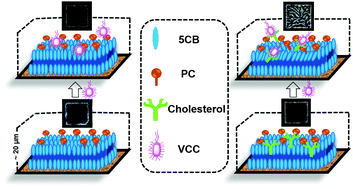Elucidating liquid crystal-aqueous interface for the study of cholesterol-mediated action of a β-barrel pore forming toxin†
Abstract
Pore-forming toxins (PFTs) produced by pathogenic bacteria serve as prominent virulence factors with potent cell-killing activity. Most of the β-barrel PFTs form transmembrane oligomeric pores in the membrane lipid bilayer in the presence of cholesterol. The pore-formation mechanisms of the PFTs highlight well-orchestrated regulated events in the membrane environment, which involve dramatic changes in the protein structure and organization. Also, concerted crosstalk between protein and membrane lipid components appears to play crucial roles in the process. Membrane-damaging lesions formed by the pore assembly of the PFTs would also be expected to impose drastic alterations in the membrane organization, details of which remain obscure in most of the cases. Prior reports have established that aqueous interfaces of liquid crystals (LCs) offer promise as responsive interfaces for biomolecular events (at physiologically relevant concentrations), which can be visualized as optical signals. Inspired by this, herein, we sought to understand the lipid membrane interactions of a β-barrel PFT i.e., Vibrio cholerae cytolysin (VCC), using LC–aqueous interfaces. Our results show the formation of dendritic patterns upon the addition of VCC to the lipid embedded with cholesterol over the LC film. In contrast, we did not observe any LC reorientation upon the addition of VCC to the lipid-laden LC–aqueous interface in the absence of cholesterol. An array of techniques such as polarizing optical microscopy (POM), atomic force microscopy (AFM), and fluorescence measurements were utilized to decipher the LC response to the lipid interactions of VCC occurring at these interfaces. Altogether, the results obtained from our study provide a novel platform to explore the mechanistic aspects of the protein–membrane interactions, in the process of membrane pore-formation by the membrane-damaging PFTs.



 Please wait while we load your content...
Please wait while we load your content...